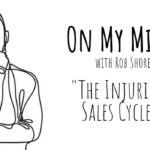Kill the squirrel.
Clean your own bathroom.
No one is going to die.
These are just three of the topics that we dive into with our special guest in this episode as we discuss his newest book, attitudes on business and being relentless.
Jeffrey Hayzlett is a primetime television host of C-Suite with Jeffrey Hayzlett and Executive Perspectives on C-Suite TV, and business podcast host of All Business with Jeffrey Hayzlett on CBS’s on-demand radio network Play.It. He is a global business celebrity, speaker, best-selling author, and Chairman of C-Suite Network, home of the world’s most trusted network of C-Suite leaders.
Hayzlett is a well-traveled public speaker, the author of three bestselling business books, Think Big, Act Bigger: The Rewards of Being Relentless, Running the Gauntlet and The Mirror Test. He is one of the most compelling figures in business today and an inductee to the Speaker Hall of Fame.
Book Jeffrey for your next event through Wholesaler Masterminds Speakers Bureau.
Pick up a copy of Jeffrey’s book Think Big, Act Bigger: The Rewards of Being Relentless.
Sales Strategy Tips for Wholesalers Who Want to Win
Like many things in life, having a strategy in mind makes accomplishing your goals that much easier. Whether you’re a wholesaler or a head of sales at a Fortune 100 company, you need a plan. For instance, an athlete wouldn’t play a game without having a strategy in place to increase his chances of winning, am I right? Or, you wouldn’t go to the grocery store without having a planned shopping list to follow. There’s a reason why they’re called “impulse buys,” and with a list in hand you’re much less likely to spring for junk you really don’t need. A strategy is more than just selling. What kinds of sales do you want, or better yet, need for your business to prosper or scale? If you aren’t growing your sales, you are dying.
The same concept goes for wholesalers. Sure, everyone knows that the end goal is to make a sale, but what steps can you take in the process to ensure that you’re successful? That’s where a strategic plan or sales strategy comes into the picture. And once you have an effective one at the ready, reaching your goals will be a lot easier, plus you’ll be a lot more efficient in the process—giving you more time to focus on additional sales. But here’s the best part: it only takes a few steps to create your winning sales strategy. Here’s how:
Step 1: Conduct a SWOT Analysis
A SWOT analysis is when you identify your Strengths, Weaknesses, Opportunities, and Threats. By looking back and studying a few of your previous sales, you’ll have a better understanding of what you did right and where there might be some room for improvement. A good way of doing this is to take a piece of paper and divide it into four squares, one square for strengths, one for weaknesses, etc. Once you’re done filling it out, you can quickly scan your chart and immediately see where you stand. (So don’t crumble it up and throw it out when you’re done—you’ll want to refer back to it in the future!).
Step 2: Do Your Homework
This may sound obvious, but figure out which clients you want to target. Take a moment to study their websites and get a feel for each company. Why would such-and-such a company need your product or services? Figure out what some of the benefits would be for them. There’s a reason why recruiters recommend that job candidates research potential employers: so that they’ll go into interviews with some knowledge of a company. The same thing goes for sales calls. Figure out which person within an organization is the designated buyer. Otherwise you’ll not only be wasting your own time but that of someone else’s too.
Step 3: Define Your Conditions of Satisfaction
Before you pick up the phone or send an email, make sure you have a clear idea of what your goal is, essentially you need to decide what end result with satisfy you. It may sound obvious, but ask yourself these questions: What do you want to sell? If it’s a product, what’s the quantity? What’s the price point? What’s the timeline for deliverables? The person you’re selling to will no doubt come back with similar questions, but by already knowing the answers you’re one step away to closing the deal and less likely to be caught off guard by an unexpected question.
Step 4: Decide on Your Sales Channel
Thanks to technology, the ways to connect with potential customers is more varied than ever before. Gone are the days when door-to-door salesmen and newspaper ads were pretty much the only way to get your product and services in front of buyers. Today, salespeople can choose from multiple avenues to reach customers. Some examples would be email blasts and social media. But because options are so plentiful, there’s no longer one, cookie cutter sales channel you should be using. If you’ve followed my advice in this article thus far, you will have researched your target company and figured out who your contact is. If the person is active on social media, this might be a good way to reach them rather than sending a formal letter via snail mail. If the person is a bit more old school, you might consider going in a more traditional route.
Step 5: Stay on Track
So you’ve made contact with your potential customer and things are looking good and you made your sale. The future is looking bright, but your story shouldn’t end there. Instead, you need to nurture this new business relationship. Check in every now and then to see if they’re satisfied with the product or services you sold them. By staying in the picture and showing interest, they’re more likely to want to do future business with you. So stay connected.
By having an effective sales strategy in place, you’ll help to increase your success as a salesperson and streamline your day-to-day tasks. In sum, I think Benjamin Franklin said it best: “If you fail to plan, you’re planning to fail.”
Written by Jeffrey Hayzlett


 On My Mind: Part Two – What Does The Path To “Normal” Wholesaling Look Like After Covid-19?
On My Mind: Part Two – What Does The Path To “Normal” Wholesaling Look Like After Covid-19? Client Service Models for Wholesalers and Their Advisors with Paul Kingsman
Client Service Models for Wholesalers and Their Advisors with Paul Kingsman The Myth of Wholesaler Work Life Balance with Chris Johnson
The Myth of Wholesaler Work Life Balance with Chris Johnson On My Mind: The Injurious Sales Cycle?
On My Mind: The Injurious Sales Cycle? 3 Ways Wholesalers Make a Difference in the Lives of Their Clients, Coworkers, Family and Friends with Mark Scharenbroich
3 Ways Wholesalers Make a Difference in the Lives of Their Clients, Coworkers, Family and Friends with Mark Scharenbroich